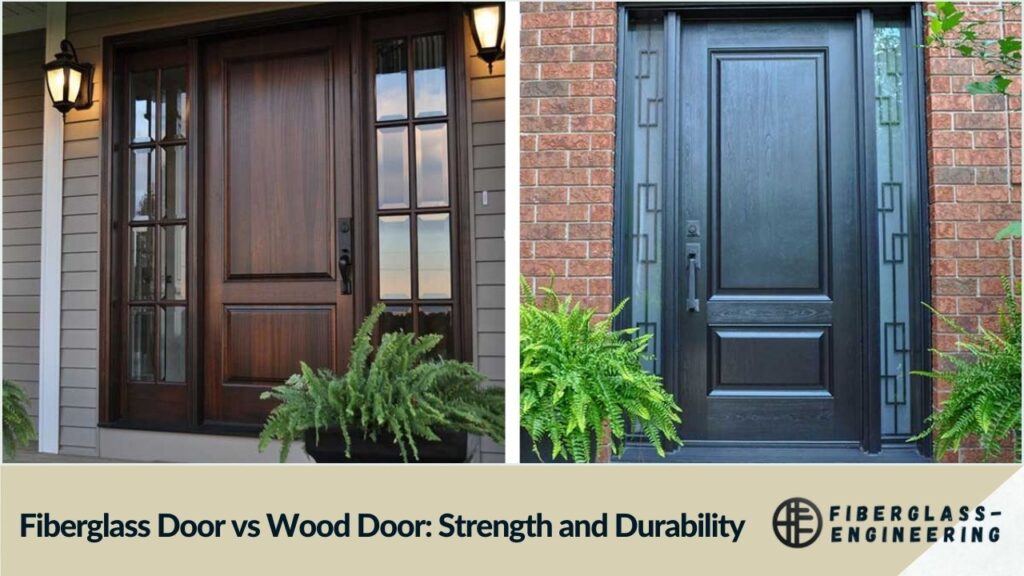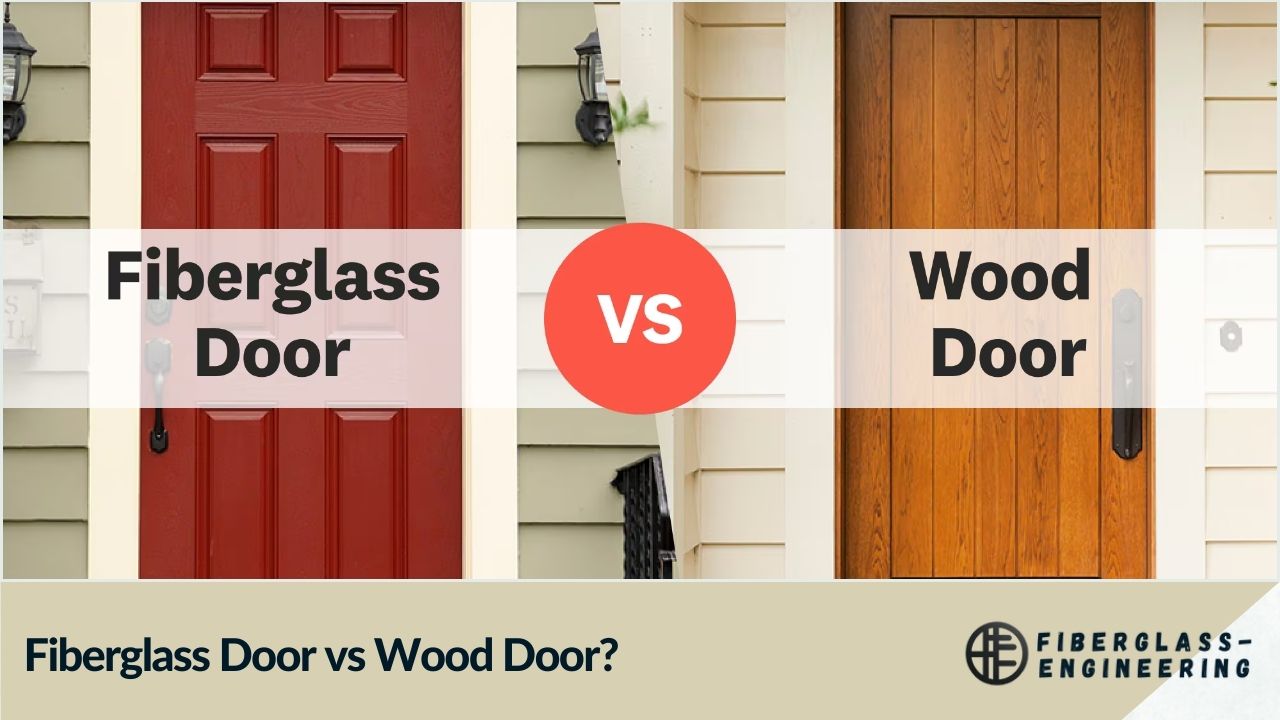When it comes to choosing the perfect entry door for your home, the debate between fiberglass and wood doors is a common one. Both materials offer unique advantages and potential drawbacks, making the decision a crucial one for homeowners. In this comprehensive guide, we'll explore the key differences between fiberglass and wood doors, helping you make an informed decision for your home.
Strength and Durability

One of the most significant factors to consider when comparing fiberglass and wood doors is their strength and durability. Fiberglass doors have a clear advantage in this area, as they are engineered to withstand harsh environmental conditions and daily wear and tear.
Fiberglass doors are constructed using extremely fine glass fibers woven together, creating a strong and durable material. This composition makes fiberglass doors highly resistant to dents, scratches, and warping. They can maintain their shape and structural integrity even in extreme weather conditions, including high humidity and temperature fluctuations.
Wood doors, while naturally strong, are more susceptible to environmental damage. They can warp, rot, or crack when exposed to moisture and temperature changes. However, with proper maintenance and protection, wood doors can still offer long-lasting durability.
Maintenance Requirements
When it comes to maintenance, fiberglass doors are the clear winner. They require minimal upkeep to maintain their appearance and functionality. A simple wipe-down with soap and water is usually sufficient to keep a fiberglass door looking its best.
Wood doors, on the other hand, demand more attention and care. They require regular staining or painting to protect the wood from moisture and UV damage. Without proper maintenance, wood doors can deteriorate quickly, leading to issues such as rotting, warping, or cracking.
Energy Efficiency
Energy efficiency is a crucial consideration for many homeowners, and in this aspect, fiberglass doors have a significant advantage. Fiberglass doors offer superior insulation properties compared to their wood counterparts.
The core of a fiberglass door is typically filled with polyurethane foam, which provides excellent thermal insulation. This insulation helps maintain a consistent indoor temperature, potentially reducing heating and cooling costs. Additionally, fiberglass doors often come with weatherstripping and tight seals, further enhancing their energy efficiency.
Wood doors, while naturally insulating, generally don't match the energy efficiency of fiberglass doors. However, some high-end wood doors with proper weatherstripping and insulation can offer comparable energy performance.
Aesthetics and Customization
When it comes to aesthetics, wood doors have traditionally been the preferred choice for their natural beauty and warmth. Wood doors offer a classic, timeless appeal that can enhance the character of any home. They can be easily customized with various finishes, stains, and intricate designs.
However, fiberglass doors have made significant strides in mimicking the appearance of wood. Modern manufacturing techniques allow fiberglass doors to closely resemble various wood grains and textures. While a discerning eye might still be able to tell the difference, fiberglass doors can provide a very convincing wood-like appearance.
Fiberglass doors also offer a wide range of customization options. They can be painted in any color and are available in various styles, from traditional to contemporary. Some manufacturers even offer fiberglass doors with decorative glass inserts, further expanding the design possibilities.
Cost Considerations
The cost of fiberglass and wood doors can vary significantly depending on the quality, style, and manufacturer. Generally, fiberglass doors tend to be more cost-effective in the long run due to their durability and low maintenance requirements.
While the initial cost of a high-quality fiberglass door may be comparable to or slightly higher than a wood door, the long-term savings in maintenance and potential replacement costs can make fiberglass a more economical choice over time.
Wood doors, especially those made from high-quality hardwoods, can be quite expensive. When factoring in the ongoing maintenance costs and potential need for earlier replacement, wood doors may end up being more costly over their lifetime.
Security and Safety
Both fiberglass and wood doors can provide excellent security when properly installed and equipped with high-quality locks and hardware. However, fiberglass doors may have a slight edge in terms of overall security.
Fiberglass doors are incredibly strong and resistant to forced entry. They don't splinter or crack easily, making them difficult to break through. Additionally, fiberglass doors don't swell or shrink with weather changes, ensuring a consistent fit in the frame and maintaining the integrity of the locking mechanism.
Wood doors, while sturdy, can potentially weaken over time due to moisture exposure or improper maintenance. This could potentially compromise their security. However, a well-maintained, solid wood door with proper hardware can still provide excellent security.
Environmental Impact
When considering the environmental impact, wood doors have an advantage as they are made from a renewable resource. Sustainably sourced wood doors can be an eco-friendly choice for environmentally conscious homeowners.
Fiberglass doors, while not biodegradable, are extremely durable and long-lasting. This longevity means they need to be replaced less frequently, potentially reducing overall resource consumption and waste. Additionally, the energy efficiency of fiberglass doors can contribute to lower energy use over time.
Installation and Sizing
Installation complexity can vary between fiberglass and wood doors. Wood doors are generally easier to customize on-site if adjustments are needed to fit non-standard door frames. They can be easily trimmed or planed to achieve the perfect fit.
Fiberglass doors, on the other hand, come as pre-hung units and are more challenging to modify. They are best suited for standard-sized door openings. If you have a non-standard door frame, you may need to adjust the frame rather than the door itself, which can add to the installation complexity and cost.
Weather Resistance
In terms of weather resistance, fiberglass doors outperform wood doors significantly. Fiberglass is inherently resistant to moisture, UV rays, and extreme temperature changes. This resistance helps fiberglass doors maintain their appearance and structural integrity even in harsh weather conditions.
Wood doors, while beautiful, are more susceptible to weather-related damage. They can absorb moisture, leading to swelling, warping, or rotting. Prolonged exposure to sunlight can cause fading and degradation of the wood surface. While proper sealing and regular maintenance can mitigate these issues, wood doors generally require more attention to withstand various weather conditions.
Conclusion
Choosing between a fiberglass door and a wood door ultimately depends on your specific needs, preferences, and budget. Fiberglass doors offer superior durability, energy efficiency, and low maintenance, making them an excellent choice for homeowners looking for a long-lasting, practical solution. Wood doors, on the other hand, provide unmatched natural beauty and a classic appeal that can enhance the character of any home.
Consider your local climate, your home's architectural style, your maintenance preferences, and your budget when making your decision. Whichever option you choose, investing in a high-quality door will enhance your home's security, energy efficiency, and curb appeal for years to come.
FAQs
- Are fiberglass doors stronger than wood doors?
Yes, fiberglass doors are generally stronger and more durable than wood doors, resisting dents, scratches, and warping better. - Do fiberglass doors look like real wood?
Modern fiberglass doors can closely mimic wood grain and texture, but a discerning eye may still notice the difference. - Which door type is more energy-efficient?
Fiberglass doors typically offer better energy efficiency due to their foam core insulation and tight seals. - Are wood doors more expensive than fiberglass?
Initially, wood doors can be more expensive, especially high-quality hardwood options. Long-term, fiberglass may be more cost-effective due to lower maintenance needs. - Can fiberglass doors be painted?
Yes, fiberglass doors can be painted in any color, offering great flexibility in design and style.

